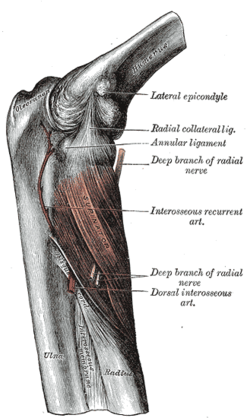Function
The interosseous membrane divides the forearm into anterior and posterior compartments, serves as a site of attachment for muscles of the forearm, and transfers loads placed on the forearm.
The interosseous membrane is designed to shift compressive loads (as in doing a hand-stand) from the distal radius to the proximal ulna. The fibers within the interosseous membrane are oriented obliquely so that when force is applied the fibers are drawn taut, shifting more of the load to the ulna. This reduces the wear and tear of placing the whole load on a single joint. [1] The role of the membrane in load shifting is illustrated when the interosseous membrane is cut; the forces on each bone equalize from their natural proportions. [2]
Additionally, as the forearm moves from pronation to supination, the interosseous membrane fibers change from a relaxed state, to a tense state in the neutral position. They once again become relaxed as the forearm enters pronation.
The interosseous membrane is composed of five ligaments:
- Central band (key portion to be reconstructed in case of injury)
- Accessory band
- Distal oblique bundle
- Proximal oblique cord
- Dorsal oblique accessory cord
This page is based on this
Wikipedia article Text is available under the
CC BY-SA 4.0 license; additional terms may apply.
Images, videos and audio are available under their respective licenses.

